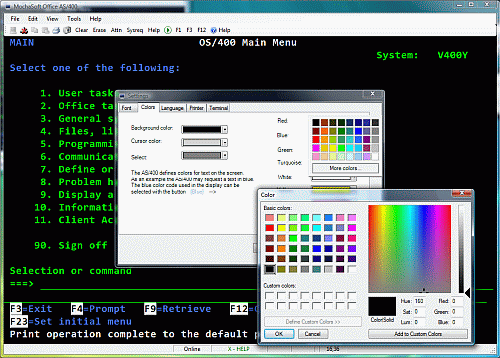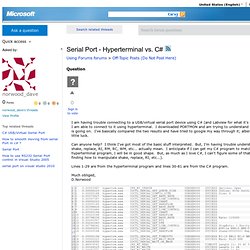Serial Port Hyperterminal
If you’ve recently upgraded to Windows 7 or Windows 10 and are wondering what happened to HyperTerminal, you’re not alone! HyperTerminal was a sweet little program that let you connect to other computers, Telnet sites, host computers, BBSs, etc. using your modem or Ethernet connection.
HyperTerminal was a sweet little program that let you connect to other computers, Telnet sites, host computers, BBSs, etc. Using your modem or Ethernet connection. In Windows 7, Vista, and 10, you will no longer find the HyperTerminal program. If you need HyperTerminal to control serial devices, there is a way to get it back!

In Windows 7, Vista, and 10, you will no longer find the HyperTerminal program. If you need HyperTerminal to control serial devices, there is a way to get it back! Also, there are several new alternatives to HyperTerminal that are probably better for secure shell access and troubleshooting modems.

Windows Remote Shell
Firstly, if you only need remote shell access, you can use the new Windows Remote Shell command line option in Windows 7/8/10. To learn more about using WRS, simply open a command prompt and type in winrs /?.
It’s basically a SSH replacement that allows remote command line access over an encrypted connection. It also uses the SOAP protocol. You can also check out the Microsoft doc on winrs that gives you some examples.
Phone and Modem Options
If you were using HyperTerminal to troubleshoot modems, you can now use Phone and Modem Options to do this. Go to Control Panel, click on Hardware and Sounds and then click on Phone and Modem Options. If you don’t see it there, click on the drop down by View items and choose Small icons or Large icons.
All you have to do is provide information about the Country/Region, Area Code, Carrier Code, and Outside Dial Number to access the dialog box. Once you do that, you can troubleshoot your modem in Windows 7 or Vista.
HyperTerminal Alternatives
If you don’t want to use all these alternative methods, you can still use alternative programs for HyperTerminal. Here are some of my favorites.
HyperTerminal Private Edition – This is a commercial terminal emulation program that you can use to communicate with serial COM ports, dial-up modems, and TCP/IP networks. If you need a good HyperTerminal program for Windows 10, then this is your best option.
TeraTerm – TeraTerm is an open-source terminal emulator and SSH module that supports IPv6, SSH1, SSH2, Telnet, serial ports, and file transfer protocols (XMODEM, Kermit, ZMODEM, B-PLUS, etc).
Putty – Another free Telnet and SSH implementation for Windows. It also is an xterm terminal emulator. This is probably my favorite alternative to HyperTerminal.
Original XP HyperTerminal

If you just can’t live without the original HyperTerminal in Windows XP, you can actually extract two files from your XP installation and copy them over to Windows 7/8/10.
The two files you will need are hypertrm.dll and hypertrm.exe. Simply copy those files into any directory on your machine and it will work. You should be able to find hypertrm.exe in C:Program FilesWindows NT and hypertrm.dll in C:WindowsSystem32.
If you have the Windows XP CD, you should be able to find both of these files in the i386 directory on the CD.
So that’s about it! Even though HyperTerminal is no longer in Windows 7/8/10, it’s really not needed since you have a lot of great alternatives like Putty, etc. If you want it simply because you’ve been using it for a long time, either download the Private Edition or copy the files from XP. Enjoy!
- To set up a serial terminal connection in HyperTerminal, First enter a name for your connection, click OK.
- Select your COM port under “connect using”.
- Click Configure and change the port settings to match the settings required by the device you are connecting to. Click OK
- Click OK again, and the program will attempt to connect.
Troubleshooting
Hyperterminal Serial Key
- Unable to open COM port COM1 COM2 COM3 The unable to open serial port message usually occurs when the com port is in use by another program. Find out which program is using the port and disconnect it. Alternatively you can use a different COM port if you have one available. Less often this issue can be caused by a permissions issue. In this case try running the program as an administrator.
- Nothing on the screen Try hitting enter a few times, or rebooting the device you are connecting to. Ensure that the cables are properly connected, or try reseating them. Ensure that you are using the type of cable required (regular or null modem depending what you are connecting to). Ensure that the serial port configuration matches the settings required by the device.
- Garbage on the screen Ensure that the port settings match the settings required by the device.
- Unable to type Some devices will not echo back typed characters. Try entering a command that should cause the device to do something you can see. Ensure that Scroll lock is not active. The SCROLL box along the bottom of the screen should be grayed out. See also “Nothing on the screen” above.
- Data appears in the wrong part of the screen Ensure that you are using the correct terminal emulator for the system you are connecting to. This can be changed by clicking File->Properties->Settings, and changing the emulation option.